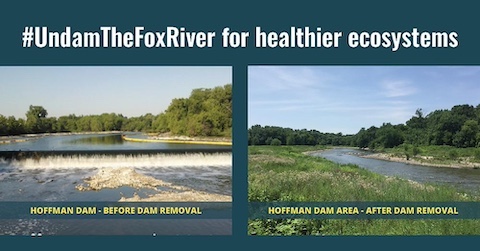As an environmental educator and advocate, I personally and professionally strive to have the most accurate and current information to share. Empowering people to care for their environment relies on assimilating information and action. In this case, we are offering an update on river restoration through dam removal and requesting that you be part of the education and advocacy process. Education for Environmental Action is the motto we follow.
Restoring Healthy Ecosystems
Ecological restoration is a young science and river restoration is a relatively new chapter. The main focus in river restoration is maintaining ecological balance, increasing biodiversity, improving the river ecosystem and water quality. Dam removal is a proven tool to restore river health, improve public safety, revitalize fish and wildlife populations, safeguard cultural values, and reconnect communities to their rivers. Dam removal also benefits the local economy through reduced infrastructure costs, increased public safety, and tourism.
Trending
The removal trend is significant. A total of 2,025 dams have been removed in the U.S. since 1912. More than half of those in the last 20 years. 65 dams in 20 states were removed in 2022. Much progress has been made on our neighboring rivers the DuPage and Des Plaines, with plans to remove all of their dams.
Fox River
In 2001, The Fox River was designated as an impaired waterway. That status (like an endangered species for plants and animals) requires the development and implementation of a plan to address the impairments and to be removed from the listing.
The Fox River Study Group (FRSG) was formed to research the Fox River’s impairments from McHenry to Ottawa. Their 2015 recommendation was to build new facilities that would remove 75% of the phosphorous discharged by our municipal wastewater treatment facilities. That action was supported and implemented by all the communities. The recommendation in 2022 was for dam removal. This action would address all the other impairments.
This past year, the United States Army Corps of Engineers (ACOE) completed a study recommending the removal of the nine dams in Kane County. The ACOE is offering 65% funding support with the Illinois Department of Natural Resources (IDNR) offering to provide the remaining 35% of the cost for design, permitting and full dam deconstruction. The McHenry, Algonquin, and Yorkville dams are not recommended for removal. Two dams on the Fox River (S. Batavia and North Ave. in Aurora) have already been removed, and several on tributaries.
Next Steps
The required public hearings and written comment periods were completed last fall. The ACOE has yet to release their responses to the nearly 1000 comments. The ACOE and IDNR (which own most of the dams) have been in communication with the nine municipalities with dams. The ACOE have made it clear from the beginning that they will not force any dam removals. Towns with IDNR-owned dams will have the option to assume full ownership and liability responsibilities if they choose to keep the dams. The ACOE is asking communities to sign a non-binding letter in support of the plan in April.
The ACOE will then go to Washington to secure the necessary funding. They will return in 2025 to begin working with municipal staff in planning and removal specifications. Deconstructions will begin in 2027.
Carpentersville Dam
This has been a lesson in patience for many of us. The latest status report is that the state level processes are complete, the plan is approved, and it is in the hands of the Kane County Forest Preserve District. There is a restriction of no deconstruction during the fish spawning period from mid-April until mid-June. Typically, a dam deconstruction of its size takes a month to complete.
Public Outreach
The largest challenge to restoring the health of the Fox River ecosystem is dispelling misinformation. The majority of those surveyed favor dam removal or want to know more about it. Please share what you know with your social circles. A list of frequently asked questions and related articles are available at FriendsoftheFoxRiver.org here. Additional resources are available under Fox River Study Group here and American Rivers here.
We are making progress in restoring the health of the Fox River. Dam removal is the most effective next step. Please help “Free the Fox River” by learning and sharing this information. Friends of the Fox River welcomes any opportunities for public education. Contact us at info@FOTFR.org or 815-356-6605. Together, WE Keep on fixin’ the Fox.



